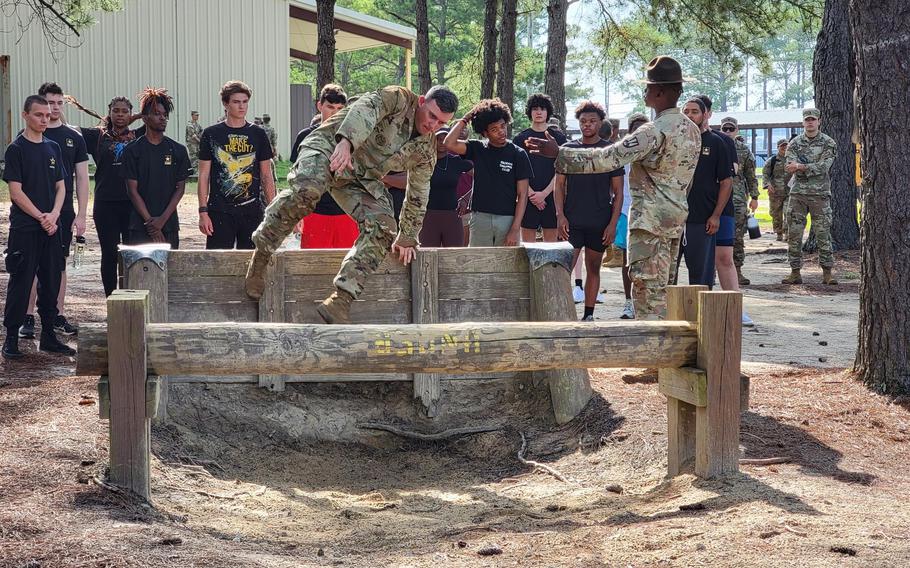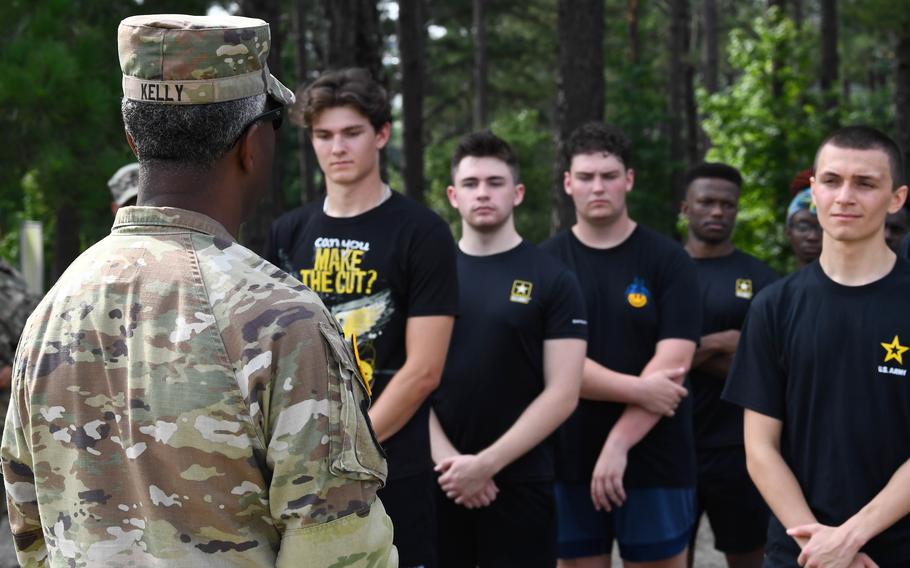
Drill sergeants with 4th Battalion, 39th Infantry Regiment, demonstrate an obstacle July 8, 2023, at the Fit to Win 2 course as part of a Future Soldier for a Day recruiting event at Fort Jackson, S.C. (U.S. Army)
WASHINGTON — The Army has improved its recruiting candidate pool and paid more than $15 million in cash bonuses since it rolled out a preparatory course a year ago to help more young Americans qualify for military service, officials said Monday.
“The results from the Future Soldier Preparatory Course have been very encouraging, providing more than 8,800 young men and women a path to serve,” said Gen. Gary Brito, commanding general for the Army Training and Doctrine Command. “The Army will continue to find innovative ways to invest in individuals who have the desire and passion to serve but may need help in meeting the Army’s enlistment standards, which we have not and will not lower.”
The Army launched the prep course on Aug. 8, 2022, because of increased difficulty recruiting qualified people in recent years, which service officials have said is rooted partly in having an all-volunteer force made worse by the coronavirus pandemic. The goal of the course is to get young Americans in better physical and academic condition so they can meet the military’s entry requirements. Since the program started, the Army said it has a 95% graduation rate. The good results have led the service to open the course at a second location — Fort Moore, Ga. — earlier this year. Officials have said further expansion is possible.
“Every day these young men and women show that when provided the right resources and training, they are able to perform and meet or exceed the standards expected of every soldier,” said Brig. Gen. Jason Kelly, commanding general at Fort Jackson, S.C.
Fewer than 25% of young Americans between the ages of 17 and 24 can meet the academic and physical requirements to join the military, according to the Pentagon. The Army’s course has two tracks: an academic track and a fitness track. At the start, potential recruits could take only one track, but the Army changed the rules in the summer to allow candidates to take both tracks as needed.

Brig. Gen. Jason Kelly, commander at Fort Jackson, S.C., speaks to a group of potential recruits during the Future Soldier for a Day recruiting event July 8, 2023. He said some people think the Army can weigh them down and keep them from being who they want to be. “I think it’s the exact opposite. I think it’s an accelerant. The Army is gas to whatever it is you want to be.” Kelly said. (U.S. Army)
“Students in the academic track [increased] their [Armed Service Vocational Aptitude Battery] scores by an average of 18.5 points, and students in the fitness track [lost] an average of 1.7% of body fat per week,” the Army said in a statement Monday. “While the numbers clearly show the program is delivering for the Army, it is also helping many young Americans who may have struggled with meeting enlistment standards realize their dream of serving their nation as a professional soldier.”
Like the Navy and Air Force, the Army has struggled to meet recruiting goals in recent years. In 2022, the service came up about 15,000 recruits shy of its target and Army Secretary Christine Wormuth has said meeting the 2023 goal of 65,000 new soldiers will be difficult.
“We are not going to make the very ambitious recruiting goal,” Wormuth said last month at the Aspen Security Forum in Colorado. “The good news is we are going to recruit more young Americans into the Army than we did last year … by several thousand.”
Officials have cited numerous contributing factors to the difficulty in recruiting across the military, including waning interest. A recent Pentagon survey showed only about 9% of Americans between 17 and 24 are interested in serving. The pandemic compounded the problem by taking thousands of recruiters out of schools nationwide.
“Test scores on the Armed Service Vocational Aptitude Battery have dropped 9% since the beginning of the COVID-19 pandemic,” Brig. Gen. Patrick Michaelis, the former commanding general at Fort Jackson, said in June. “The Army recognizes that the societal difficulties facing our youth are not going away, so we are going to do something about it ourselves and build the next generation of soldiers.”
One incentive that the Army has pursued to improve recruiting is offering cash bonuses. In the prep course, candidates can qualify to receive financial awards if they graduate.
“I started with an ASVAB score of 38,” said Pvt. Nia Bautista, a recent graduate. “I was able to increase my ASVAB score to 90 and … qualified for a bonus of $7,500.”
Since the course was launched a year ago, the Army said it’s paid out more than $15.5 million in bonuses to graduates.
“The course meant a lot to me,” said Pvt. Elysette Ortiz, who raised her ASVAB score by 22 points. “I spent a lot of time trying to get into the Army. This program helped me make it to this point.”
The Navy, which has said it expects to be a few thousand recruits short of its goal for 2023, decided earlier this year to follow the Army’s lead by launching a similar preparatory course in April. It’s designed to get recruits in physical shape so they can pass the Navy Physical Readiness Test.